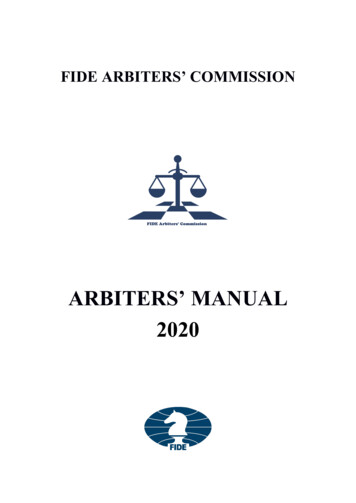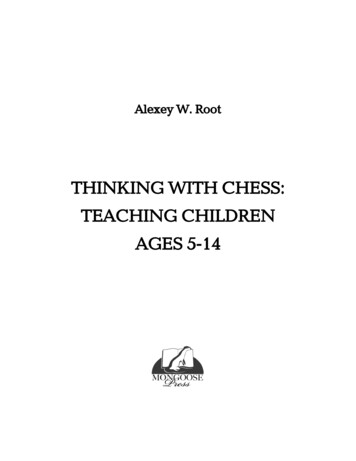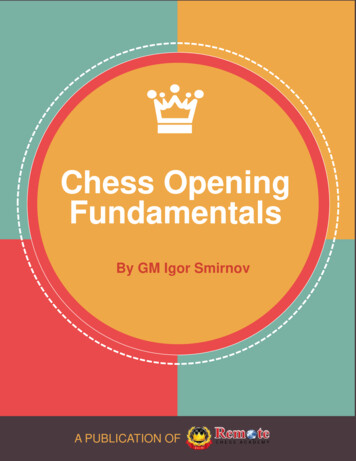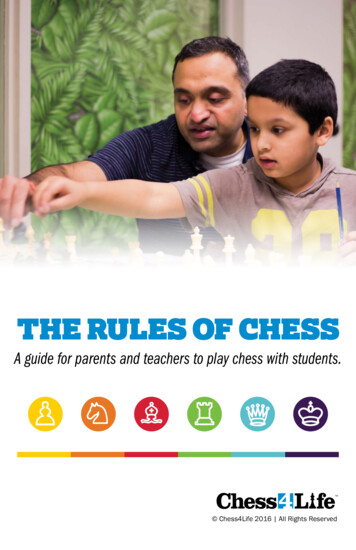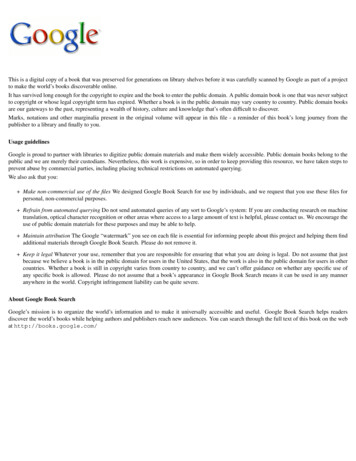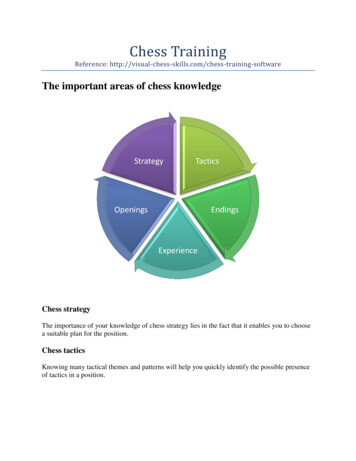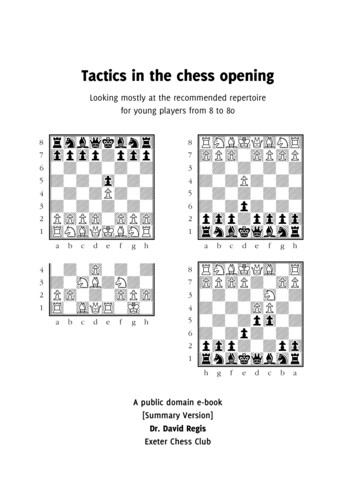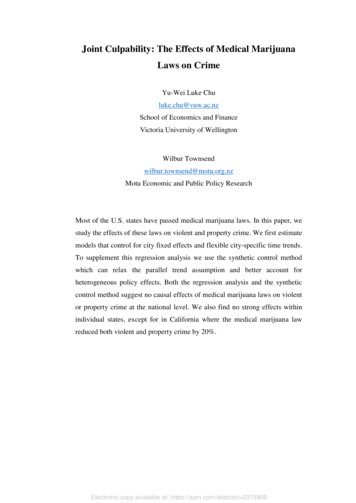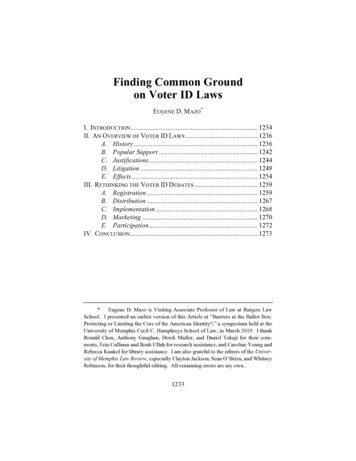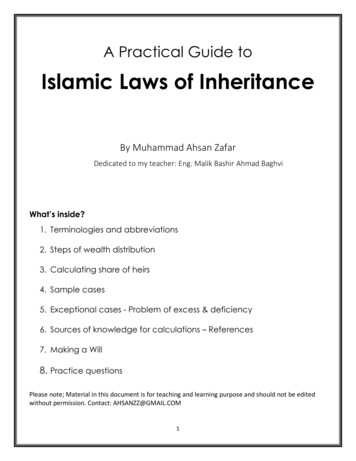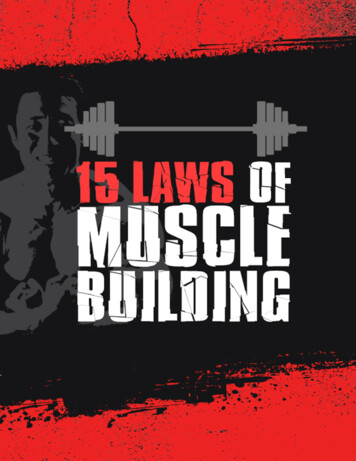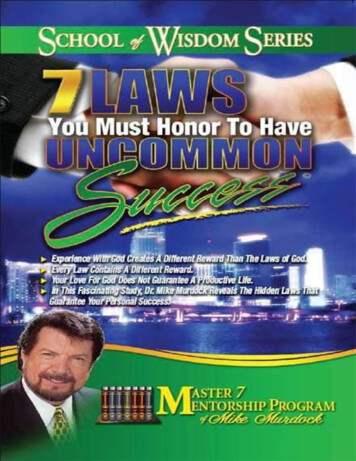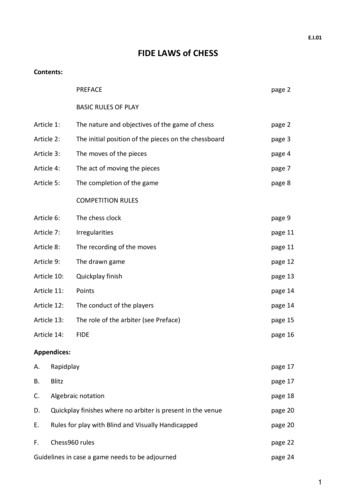
Transcription
E.I.01FIDE LAWS of CHESSContents:PREFACEpage 2BASIC RULES OF PLAYArticle 1:The nature and objectives of the game of chesspage 2Article 2:The initial position of the pieces on the chessboardpage 3Article 3:The moves of the piecespage 4Article 4:The act of moving the piecespage 7Article 5:The completion of the gamepage 8COMPETITION RULESArticle 6:The chess clockpage 9Article 7:Irregularitiespage 11Article 8:The recording of the movespage 11Article 9:The drawn gamepage 12Article 10:Quickplay finishpage 13Article 11:Pointspage 14Article 12:The conduct of the playerspage 14Article 13:The role of the arbiter (see Preface)page 15Article 14:FIDEpage 16Appendices:A.Rapidplaypage 17B.Blitzpage 17C.Algebraic notationpage 18D.Quickplay finishes where no arbiter is present in the venuepage 20E.Rules for play with Blind and Visually Handicappedpage 20F.Chess960 rulespage 22Guidelines in case a game needs to be adjournedpage 241
FIDE Laws of Chess cover over-the-board play.The English text is the authentic version of the Laws of Chess, which was adopted at the 79th FIDE Congressat Dresden (Germany), November 2008, coming into force on 1 July 2009.In these Laws the words ‘he’, ‘him’ and ‘his’ include ‘she’ and ‘her’.PREFACEThe Laws of Chess cannot cover all possible situations that may arise during a game, nor can theyregulate all administrative questions. Where cases are not precisely regulated by an Article of theLaws, it should be possible to reach a correct decision by studying analogous situations which arediscussed in the Laws. The Laws assume that arbiters have the necessary competence, soundjudgement and absolute objectivity. Too detailed a rule might deprive the arbiter of his freedom ofjudgement and thus prevent him from finding the solution to a problem dictated by fairness, logicand special factors.FIDE appeals to all chess players and federations to accept this view.A member federation is free to introduce more detailed rules provided they:a.do not conflict in any way with the official FIDE Laws of Chess, andb.are limited to the territory of the federation concerned, andc.are not valid for any FIDE match, championship or qualifying event, or for a FIDE title orrating tournament.BASIC RULES OF PLAYArticle 1: The nature and objectives of the game of chess1.1The game of chess is played between two opponents who move their pieces alternatelyon a square board called a ‘chessboard’. The player with the white pieces commences thegame. A player is said to ‘have the move’, when his opponent’s move has been ‘made’.(See Article 6.7)1.2The objective of each player is to place the opponent’s king ‘under attack’ in such a waythat the opponent has no legal move. The player who achieves this goal is said to have‘checkmated’ the opponent’s king and to have won the game. Leaving one’s own kingunder attack, exposing one’s own king to attack and also ’capturing’ the opponent’s kingare not allowed. The opponent whose king has been checkmated has lost the game.1.3If the position is such that neither player can possibly checkmate, the game is drawn.2
Article 2: The initial position of the pieces on the chessboard2.1The chessboard is composed of an 8 x 8 grid of 64 equal squares alternately light (the‘white’ squares) and dark (the ‘black’ squares).The chessboard is placed between the players in such a way that the near corner squareto the right of the player is white.2.2At the beginning of the game one player has 16 light-coloured pieces (the ‘white’ pieces);the other has 16 dark-coloured pieces (the ‘black’ pieces).These pieces are as follows:A white kingusually indicated by the symbolA white queenusually indicated by the symbolTwo white rooksusually indicated by the symbolTwo white bishopsusually indicated by the symbolTwo white knightsusually indicated by the symbolEight white pawnsusually indicated by the symbolA black kingusually indicated by the symbolA black queenusually indicated by the symbolTwo black rooksusually indicated by the symbolTwo black bishopsusually indicated by the symbolTwo black knightsusually indicated by the symbolEight black pawnsusually indicated by the symbol2.3The initial position of the pieces on the chessboard is as follows:2.4The eight vertical columns of squares are called ‘files’. The eight horizontal rows ofsquares are called ‘ranks’. A straight line of squares of the same colour, running from oneedge of the board to an adjacent edge, is called a ‘diagonal’.3
Article 3: The moves of the pieces3.1It is not permitted to move a piece to a square occupied by a piece of the same colour. Ifa piece moves to a square occupied by an opponent’s piece the latter is captured andremoved from the chessboard as part of the same move. A piece is said to attack anopponent’s piece if the piece could make a capture on that square according to theArticles 3.2 to 3.8.A piece is considered to attack a square, even if such a piece is constrained from movingto that square because it would then leave or place the king of its own colour underattack.3.2The bishop may move to any square along a diagonal on which it stands.3.3The rook may move to any square along the file or the rank on which it stands.3.4The queen may move to any square along the file, the rank or a diagonal on which itstands.4
3.5When making these moves the bishop, rook or queen may not move over any interveningpieces.3.6The knight may move to one of the squares nearest to that on which it stands but not onthe same rank, file or diagonal.3.7a.b.c.d.The pawn may move forward to the unoccupied square immediately in front of it onthe same file, oron its first move the pawn may move as in 3.7.a or alternatively it may advance twosquares along the same file provided both squares are unoccupied, orthe pawn may move to a square occupied by an opponent’s piece, which isdiagonally in front of it on an adjacent file, capturing that piece.A pawn attacking a square crossed by an opponent’s pawn which has advanced twosquares in one move from its original square may capture this opponent’s pawn asthough the latter had been moved only one square. This capture is only legal on themove following this advance and is called an ‘en passant’ capture.5
3.8e.When a pawn reaches the rank furthest from its starting position it must beexchanged as part of the same move on the same square for a new queen, rook,bishop or knight of the same colour. The player’s choice is not restricted to piecesthat have been captured previously. This exchange of a pawn for another piece iscalled ‘promotion’ and the effect of the new piece is immediate.a.There are two different ways of moving the king:by moving to any adjoining square not attacked by one or more of the opponent’spiecesor by ‘castling’. This is a move of the king and either rook of the same colour alongthe player’s first rank, counting as a single move of the king and executed asfollows: the king is transferred from its original square two squares towards therook on its original square, then that rook is transferred to the square the king hasjust crossed.Before white kingside castlingBefore black queenside castlingAfter white kingside castlingAfter black queenside castlingBefore white queenside castlingBefore black kingside castlingAfter white queenside castlingAfter black kingside castling6
b.3.9(1)The right to castle has been lost:[a] if the king has already moved, or[b] with a rook that has already moved.(2)Castling is prevented temporarily:[a] if the square on which the king stands, or the square which it mustcross, or the square which it is to occupy, is attacked by one or more ofthe opponent's pieces, or[b] if there is any piece between the king and the rook with which castling isto be effected.The king is said to be 'in check' if it is attacked by one or more of the opponent's pieces,even if such pieces are constrained from moving to that square because they would thenleave or place their own king in check. No piece can be moved that will either expose theking of the same colour to check or leave that king in check.Article 4: The act of moving the pieces4.1Each move must be made with one hand only.4.2Provided that he first expresses his intention (for example by saying „j’adoube“ or “Iadjust”), the player having the move may adjust one or more pieces on their squares.4.3Except as provided in Article 4.2, if the player having the move deliberately touches onthe chessboard:a.one or more of his own pieces, he must move the first piece touched which can bemovedb.one or more of his opponent’s pieces, he must capture the first piece touchedwhich can be capturedc.one piece of each colour, he must capture the opponent’s piece with his piece or, ifthis is illegal, move or capture the first piece touched which can be moved orcaptured. If it is unclear, whether the player’s own piece or his opponent’s wastouched first, the player’s own piece shall be considered to have been touchedbefore his opponent’s.4.4If a player having the move:a.deliberately touches his king and rook he must castle on that side if it is legal to dosob.deliberately touches a rook and then his king he is not allowed to castle on that sideon that move and the situation shall be governed by Article 4.3.ac.intending to castle, touches the king or king and rook at the same time, but castlingon that side is illegal, the player must make another legal move with his king (whichmay include castling on the other side). If the king has no legal move, the player isfree to make any legal moved.promotes a pawn, the choice of the piece is finalised, when the piece has touchedthe square of promotion.7
4.5If none of the pieces touched can be moved or captured, the player may make any legalmove.4.6When, as a legal move or part of a legal move, a piece has been released on a square, itcannot be moved to another square on this move. The move is then considered to havebeen made:a.in the case of a capture, when the captured piece has been removed from thechessboard and the player, having placed his own piece on its new square, hasreleased this capturing piece from his handb.in the case of castling, when the player's hand has released the rook on the squarepreviously crossed by the king. When the player has released the king from hishand, the move is not yet made, but the player no longer has the right to make anymove other than castling on that side, if this is legalc.in the case of the promotion of a pawn, when the pawn has been removed from thechessboard and the player's hand has released the new piece after placing it on thepromotion square. If the player has released from his hand the pawn that hasreached the promotion square, the move is not yet made, but the player no longerhas the right to play the pawn to another square.The move is called legal when all the relevant requirements of Article 3 have beenfulfilled. If the move is not legal, another move shall be made instead as per Article 4.5.4.7A player forfeits his right to a claim against his opponent’s violation of Article 4 once hedeliberately touches a piece.Article 5: The completion of the game5.1a.b.5.2a.b.c.d.e.The game is won by the player who has checkmated his opponent’s king. Thisimmediately ends the game, provided that the move producing the checkmateposition was a legal move.The game is won by the player whose opponent declares he resigns. Thisimmediately ends the game.The game is drawn when the player to move has no legal move and his king is not incheck. The game is said to end in ‘stalemate’. This immediately ends the game,provided that the move producing the stalemate position was legal.The game is drawn when a position has arisen in which neither player cancheckmate the opponent’s king with any series of legal moves. The game is said toend in a ‘dead position’. This immediately ends the game, provided that the moveproducing the position was legal. (See Article 9.6)The game is drawn upon agreement between the two players during the game. Thisimmediately ends the game. (See Article 9.1)The game may be drawn if any identical position is about to appear or has appearedon the chessboard at least three times. (See Article 9.2)The game may be drawn if each player has made at least the last 50 consecutivemoves without the movement of any pawn and without any capture. (See Article9.3)8
COMPETITION RULESArticle 6: The chess clock6.1‘Chess clock’ means a clock with two time displays, connected to each other in such a waythat only one of them can run at one time.‘Clock’ in the Laws of Chess, means one of the two time displays.Each time display has a ‘flag’.‘Flag fall’ means the expiration of the allotted time for a player.6.2a.b.When using a chess clock, each player must make a minimum number of moves orall moves in an allotted period of time and/or may be allocated an additionalamount of time with each move. All these must be specified in advance.The time saved by a player during one period is added to his time available for thenext period, except in the ‘time delay’ mode.In the time delay mode both players receive an allotted ‘main thinking time’. Eachplayer also receives a ‘fixed extra time’ with every move. The countdown of themain time only commences after the fixed time has expired. Provided the playerstops his clock before the expiration of the fixed time, the main thinking time doesnot change, irrespective of the proportion of the fixed time used.6.3Immediately after a flag falls, the requirements of article 6.2 a. must be checked.6.4Before the start of the game the arbiter decides where the chess clock is placed.6.5At the time determined for the start of the game the clock of the player who has thewhite pieces is started.6.6a.Any player who arrives at the chessboard after the start of the session shall lose thegame. Thus the default time is 0 minutes. The rules of a competition may specifyotherwise.b.If the rules of a competition specify a different default time, the following shallapply. If neither play
FIDE appeals to all chess players and federations to accept this view. A member federation is free to introduce more detailed rules provided they: a. do not conflict in any way with the official FIDE Laws of Chess, and b. are limited to the territory of the federation concerned, and c. are not valid for any FIDE match, championship or qualifying event, or fora FIDE title or rating tournament .
